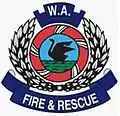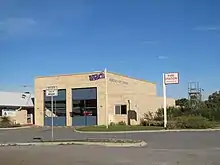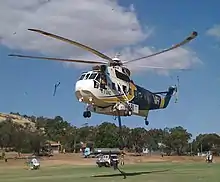 Government agency logo | |
 WA Fire and Rescue (urban areas) | |
 WA Bush Fire Service (rural areas) | |
| Agency overview | |
|---|---|
| Formed | 2012 |
| Preceding agency |
|
| Jurisdiction | Government of Western Australia |
| Motto | Working together for a safer state |
| Minister responsible |
|
| Agency executive |
|
| Child agencies |
|
| Website | www.dfes.wa.gov.au |
The Department of Fire and Emergency Services (DFES) is a government department that is responsible for fire and emergency services in Western Australia. The department came into being in 2012 as a result of the Perth Hills Bush Fire review.[1] DFES is responsible for the management, training and funding of career and volunteer Services including:[2]
- The Bush Fire Service (BFS)
- Volunteer Fire and Rescue Service (VFRS)
- Career Fire and Rescue Service (CFRS or FRS)
- Volunteer Fire and Emergency Service (VFES)
- State Emergency Service (SES)
- Volunteer Marine Rescue Service (VMRS)
History
The DFES was formerly known as the Fire and Emergency Services Authority of Western Australia (FESA), a statutory government authority created in January 1999 to administer the following legislation within the state of Western Australia:[3]
- Fire and Emergency Services Authority of Western Australia Act 1998
- Fire Brigades Act 1942
- Bush Fires Act 1954
- Emergency Services Levy Act 2002
- Emergency Management Act 2005
In the July 2017 Western Australian machinery of government changes, the department remained unaffected.[4]
Fire and Rescue Service of Western Australia

The inaugural meeting of the Fire Brigades' Board was held on 16 January 1899. This later led to the establishment of the Western Australian Fire Brigades' Board in 1909. WA Fire Brigades updated their name in 1995 to the Fire and Rescue Service of Western Australia, to more accurately reflect the service provided to the communities of Western Australia.[5]
In 1999, with the creation of FESA, brought together the Fire and Rescue Service, and the Bush Fire Service to form the Fire Services Division of FESA. The Fire and Rescue Service and Bush Fire Service actively maintain their original identities.
The Department of Fire and Emergency Services was established in 2012 and replaced FESA. The first Fire and Emergency Commissioner Wayne Gregson was appointed. Wayne Gregson is a former WA Police Assistant Commissioner. A new state of the art headquarters is located at Stockton Bend, Cockburn Central. This building includes the state and metropolitan operations centres, statewide communications centre, operations/capability commands and corporate services.
Structure
DFES operates under the Emergency Services Minister of the Government of WA and is the Hazard Management Agency (HMA) for cyclones, floods, storms, tsunami, structural collapse, HAZMAT incidents, earthquakes and fire. Their operational branch comprises Metropolitan Operations, Country Operations and Operations Capability and oversees the following services:
The Career Fire and Rescue Service of Western Australia (FRS or CFRS) consists of 1,190 paid firefighters working from 25 metropolitan stations and 4 country stations. Career firefighters attend a 21 week training course held at the academy in Forrestfield. Working on a 2-2-4 roster of two 10 hour day shifts followed by two 14 hour night shifts and then 4 days off. Metropolitan stations operate with at least one urban pumper and light tanker, with a crew of 1 station officer and 3 firefighters. (Perth station does not run light tankers). Country stations operate with a crew of 1 station officer and 4 fire fighters.[6] Some metropolitan stations operate as relieving stations where 2 additional firefighters are on shift, these firefighters will fill short staffing at other stations if the need arises.
Appliance allocation is typically 1 urban pumper and 1 light tanker, with a 2nd pump located at Perth, Vincent, Daglish, Fremantle, Welshpool and Bunbury. Two CLP's are located at Perth and Freemantle stations. Two SET's are located at Murdoch and Osborne Park. Three permanent Urban Tankers are located at Joondalup, Malaga and Canning Vale. With additional Urban Tankers brought online at Ellenbrook, Hope Valley and Maddington, during the high threat period. The ICV is located at Belmont Station.
The Volunteer Fire and Rescue Service (VFRS) is a volunteer service predominantly attending motor vehicle accidents, structure fires and HAZMAT incidents outside of metropolitan areas. In 2019 the VFRS had 2,371 volunteer firefighters in 94 brigades across the state.[7][8]
The Bush Fire Service (BFS) is a volunteer service tasked with attending any fire outside of a gazetted fire district within a Brigade's Local Government area. They predominantly combat bushfires and conduct hazard reduction burning on a local level. As of 2019, there are 566 Bush Fire Brigades (BFBs) with 19,521 volunteers.[9]
The Volunteer Fire and Emergency Services (VFES) is also a volunteer service. It was established to combine the resources of any combination of a BFS Brigade, a VFRS Brigade, VMRS Group or an SES Unit to replace the Volunteer Fire Services (VFS) and Volunteer Emergency Service (VES) in 2016[10] It has just over 1,000 volunteers as of 2019.
The State Emergency Service (SES) is a volunteer service with the role of attending a vast array of natural disasters and search and rescue incidents. They attend land searches for missing people, storm damage, urban search and rescue (USAR), cliff rescue, road crash rescue, transporting personnel and equipment to fires as well as many other roles. The SES has a K9 unit with volunteer's dogs being trained in searching for missing people and a mounted unit for land searches. As of 2019 they had 1,839 volunteers.
The Volunteer Marine Rescue Service (VMRS) is another volunteer service tasked with assisting the Western Australian Police with searches for missing people or vessels, assisting disabled vessels and rescues in water around the state. As of 2019 there are 39 VMRS Groups with 1,752 volunteers.[11]
In April 2018 a new Rural Fire Division was announced after the findings of the 2016 Waroona Bushfire Special Inquiry. It will be another branch under the DFES structure and will consist of:[12]
- Bushfire Centre of Excellence (training and research into Bushfire mitigation)[13]
- Bushfire Mitigation Branch
- Bushfire Technical Services
- Land Use Planning
- Office of Bushfire Risk Management
Ranks and insignia
| Title | Epaulette | Helmet | |
|---|---|---|---|
| Comissioner |  |
Crossed staffs in gold wreath with red background
below a crown. |
Black
2 x white stripes on both sides |
| Deputy Comissioner |  |
Crossed staffs in gold wreath with red background
below 3 pips |
Black
1 x white stripe on both sides |
| Assistant Commissioner |  |
Crossed staffs in gold wreath with red background
below 2 pips |
Black |
| Chief Superintendent |  |
Crossed staffs in gold wreath with red background
below 1 pip |
Silver
1 x white stripe on both sides |
| Superintendent |  |
Crossed staffs in gold wreath with red background | Silver |
| District Officer (Urban & Rural Fire) |  |
3 blue impellors | Blue
1 x white stripe |
| District Officer (Natural Hazzards) |  |
3 gold pips | Blue
1 x whte stripe |
| Area Officer |  |
2 blue impellors below a band | Blue |
| Community Emergency Services
Manager (CESM) |
 |
2 gold pips, local government name printed below | Lime green
1 x white stripe on both sides |
| Station Officer (SO) |  |
2 blue impellors | Red
2 x blue impellors on both sides |
| Leading Firefighter |  |
3 yellow chevrons below 2 crossed red axes | Yellow
3 x yellow chevrons on both sides |
| Senior Firefighter - 15 years (SFF-15) |  |
3 x chevrons ( 2 x yellow above 1 x red) below
2 crossed red axes |
Yellow
3 x chevrons ( 2 x yellow above 1 x red) on both sides |
| Senor Firefighter |  |
2 x yellow chevrons below 2 crossed red axes | Yellow
2 x yellow chevrons on both sides |
| Firefighter 1st & 2nd class |  |
1 x yellow chevron below 2 crossed red axes | Yellow
1 x yellow chevron on both sides |
| Firefighter 5th, 4th & 3rd class |  |
2 crossed red axes | Yellow |
| Trainee Firefighter |  |
Blank red epaulette | Yellow |
| VFRS Captain | 3 x red bars below a red impellor | Lime green | |
| VFRS Lieutenant | 2 x red bars below a red impellor | White
1 x blue stripe on both sides | |
| VFRS Apparatus Officer | 1 x red bar below a red impellor | White
1 x green stripe on both sides | |
| VFRS Leading Firefighter | 3 x red chevrons below 2 crossed branches | White | |
| VFRS Senior Firefighter | 2 x red chevrons below 2 crossed branches | White | |
| VFRS Qualified Firefighter | 1 x red chevron below 2 crossed branches | White | |
| VFRS Firefighter | 2 crossed branches | White | |
| VFRS Ex Captain | 1 x yellow impellow above EX CAPTAIN in writing | White | |
| VFRS Secretaty (Non-active) | 1 x yellow line above SECRETARY in writing |
Stations
Metropolitan Career fire stations

|
|
|
Country Career fire stations

Vehicles and equipmentThe Department maintains and coordinates a range of specialist equipment and emergency response vehicles. This includes pumpers and tankers, aerial ladders and other equipment designed to combat incidents including search and rescue, urban search and rescue (USAR), firefighting and other natural disasters. Appliances used by DFES brigades groups and units include:[14] BFS/VFES/VFRS/CFRS vehicles
SES/VFES vehicles
Aerial suppression and fire mappingDFES utilises a range of water bombing and surveillance aircraft on loan from various companies and in collaboration with The Department of Biodiversity, Conservation and Attractions (DBCA) Parks and Wildlife Service. During the 2019/2020 Fire season, these include:[15]
Vehicles are named based on their water capacity, drive type (2x4/4x4) and role. For example: 1.4R meaning approximately 1000L, 4x4 and designed for a rural environment. IncidentsIn February 2023, a Coulson Aviation Boeing 737-300 crashed while fighting fires in Fitzgerald River National Park; both pilots survived the crash.[17] PublicationsDFES published 24seven, a magazine.[18] See alsoWikimedia Commons has media related to Department of Fire and Emergency Services, Western Australia. References
|












